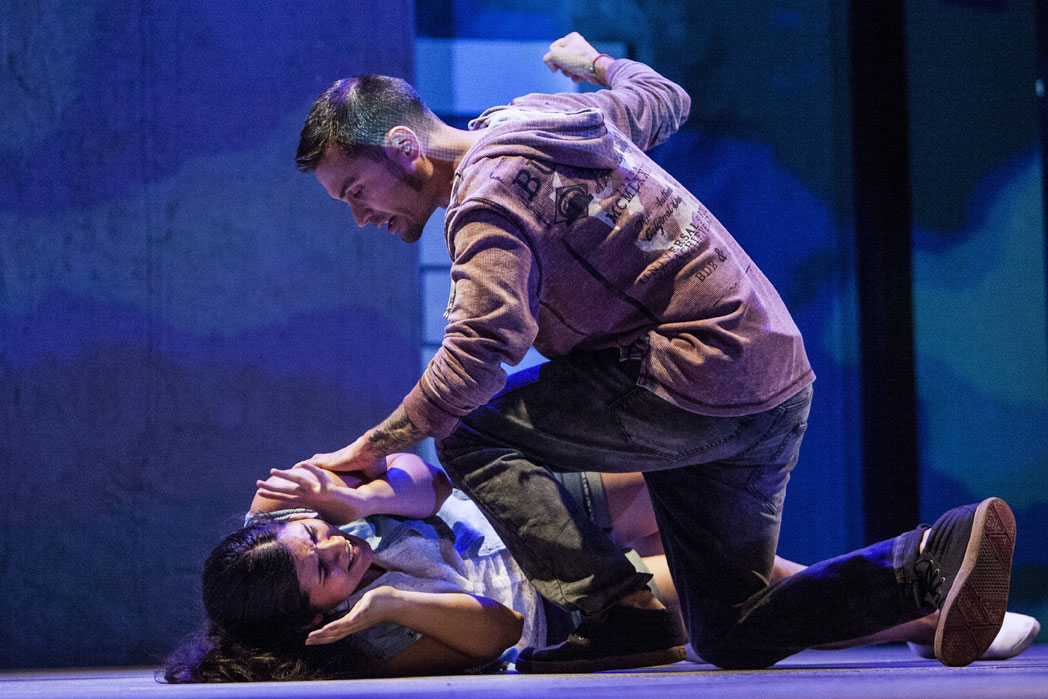Bridging the sound barrier
Story and photography by Jane Kaufman
Ask William Morgan to interpret his spoken words into American Sign Language, and there’s a hesitation.
While ASL and English are related, they don’t share a common sentence structure. A direct translation of either language won’t quite make sense.
“In English you say, ‘What’s your name?’ In ASL, you say, ‘Your name what?’” explains Morgan, artistic manager of SignStage, a program of the Cleveland Hearing & Speech Center in the University Circle neighborhood of Cleveland that engages deaf, hard of hearing and hearing students in acting as a form of communication and expression. “It becomes a little more signed English.”
In fact, Morgan says, there’s an expression that refers to signing and speaking English at the same time by a single speaker. It’s called simultaneous communication. The sign in ASL for sim-com is an “S” formed with the right hand enclosing the left hand’s “C.” The sign appears to be a bit of a visual entanglement – perhaps because sim-com is an imperfect form of communication. It challenges the speaker to think simultaneously in two quite different languages.
These inherent complexities in theatrical productions with both deaf and hearing casts, crews and audiences may contribute to the sense of closeness and shared ingenuity at SignStage as they close the gap between the hearing and deaf communities, producing shows that attract both. Back after a pandemic hiatus, the group is preparing its next production starring both deaf and hearing actors.
At SignStage, each actor’s spoken lines are signed by an interpreter; likewise each actor’s signs are voiced by a different speaker.
Through his work at SignStage, Morgan says he hopes to create “really strong bonds between deaf and hearing people.” Those bonds take hold in an environment that values each person’s contributions to the fabric of the production and where, taking a cue from deaf culture, honest communication is honored.

History of performing, educating
SignStage’s mission, according to its website, is to create programs and performances that promote awareness and demonstrate the value of cultural diversity between deaf and hearing communities. SignStage performs and holds theatrical residencies at schools and provides workshops in gesture communication skills and theater-based education programming incorporating ASL.
In July, SignStage players were in rehearsal for “Dancing Hands Jukebox,” an anthology of songs, scenes and playlets of both previously performed and newly written original material. For example, it will feature a scene from “Charlie and the Chocolate Factory,” which SignStage put on in 2019, as well as dance routines and songs.
At the first rehearsal, about a dozen actors – both deaf and hearing people of all ages – gathered to hear a synopsis of the show and begin rehearsing what’s likely to be a show-stopping and humorous take on Katrina & The Waves’ recording of “Walking on Sunshine.” Two of the cast switch off to interpret for Morgan, who is hearing, as he directs the cast.
There is a great deal of smiling and chuckling during the rehearsal as Morgan gestures broadly to convey the story, mood and vibe he hopes to create in this piece of the show, in which actors play nursing home residents startled awake by the music who begin to line dance. They then break out into improvisational dances, solo or together, and then fall back into a stupor.
SignStage began in 1975 as Fairmount Theatre of the Deaf at the Coventry Village Branch of Heights Libraries in Cleveland Heights. Founded by Brian Kilpatrick, a deaf actor, and Chas St. Clair, the troupe staged plays and interpreted them in ASL.
In 1979, the company moved to the Cleveland Play House. Under the name Cleveland Sign Stage Theatre, there were performances at the Brooks and Studio theaters. At that venue, the program won four local Emmy Awards and two Cleveland Critics’ Circle Awards.
After falling on difficult financial straits in 2000, Morgan, who was then artistic director, worked with trustees at Cleveland Hearing & Speech Center to bring SignStage under its auspices. That transition came to fruition in 2007.
One recent and successful show was “The Ugly Duckling Doesn’t Quack,” which went on national tour and then was staged in Chagrin Falls in 2018. Based on the Hans Christian Andersen fairytale, Morgan added a new dimension to the main character: deafness. That alteration allowed SignStage to educate its audiences about how a deaf child learns to speak.
Personal experience
When Jaison Anderson learned he landed the lead role in SignStage’s production of “Charlie and the Chocolate Factory” in 2019, he was surprised and nervous. The Maple Heights resident has hearing loss and had never acted before he auditioned for the show. A friend who is an interpreter suggested he try out.
“Honestly, I liked everything about it: the cast, how it was arranged, and everything was fun,” says Anderson, who now teaches ASL at Oberlin City Schools. “I mean, we worked hard. We worked together. The group was amazing – amazing people, and we all put our ideas together.”

Anderson says in rehearsals he learned to sign more broadly than he does in communicating one on one in order to get his message out, in much the same way a hearing actor needs to project. He also learned to face the front of the stage to be seen.
“Charlie and the Chocolate Factory,” as it turns out, was one of SignStage’s most popular recent productions.
“It was almost magical in a good way,” Morgan says. “These actors, they put it together.”
The camaraderie and shared creativity Anderson found at SignStage are two of the intangibles Morgan hopes to foster as deaf and hearing communities bridge the sound barrier.
Morgan says one of the surprises in landing his first role in deaf theater in 1997 was how “blunt” people are in the deaf community. If he put on weight, he says, he might be told, “Wow, you got fat.”
Members of the deaf and signing community often have a natural facility for acting because ASL depends on facial expression as an integral part of the language, he says.
“They have a real connection to the deep, deep emotion,” Morgan says. “They’ve got the expressions easily. You don’t have to show them or even ask them, and they recreate it.”
‘Higher level’ of communication
Like most theater companies across the country, SignStage took a hiatus due to the COVID-19 pandemic. Ramping back up for the first time in July since the pandemic took hold has been challenging for Morgan.
The theater where he hoped to stage SignStage’s next production has decided not to reopen just yet. So, Morgan has improvised and will offer the next production, “Dancing Hands Jukebox” by videotape.

Julianne Kuchcinski and her son Matthew Kuchcinski, 16, travel from Twinsburg to be part of the production. Both are veteran actors of SignStage.
In “Charlie and the Chocolate Factory,” Matthew played Augustus Gloop. A hearing actor, he signed the role. His mother, who is also hearing, voiced the part for him.
The two practiced signing daily during that rehearsal process and in the car on their way to rehearsals.
“I started learning sign language right out of high school,” Julianne Kuchcinski says. “I’ve done it for many years. Never knew why, I just did it for fun. And it wasn’t until I found the audition notice for ‘The Ugly Duckling’ that I thought, ‘Now I know why.’ It’s just an awesome community of people. Every show has been just amazing. … You’ve got the people who are completely deaf and the people who know very little sign language, and yet we can get along, and we can communicate to the best of our ability, and it’s just an awesome family experience.”
She says she enjoys working with Morgan because he’s supportive.
“He’s very animated,” she says. “When he’s showing you what he wants, he’s like doing it right there, and it gives you a good role model to follow. And yet, he’ll let you put your own little touch to it.”
Morgan hopes audiences note the beauty of signing as they take in the show.
“You see things you’ve never heard at a SignStage production,” he says.
With its rich emotional content, Morgan has great respect for the language of ASL as well as for the deaf community. He is also aware that what he’s doing is, in a way, sacred work.
“It’s almost like you’re lifted up to a higher level in communicating,” he says.










